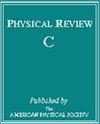Empirical fits to inclusive electron-carbon scattering data obtained by deep-learning methods
IF 3.4
2区 物理与天体物理
Q1 Physics and Astronomy
引用次数: 0
Abstract
Employing the neural network framework, we obtain empirical fits to the electron-scattering cross sections for carbon over a broad kinematic region, extending from the quasielastic peak through resonance excitation to the onset of deep-inelastic scattering. We consider two different methods of obtaining such model-independent parametrizations and the corresponding uncertainties: based on the bootstrap approach and the Monte Carlo dropout approach. In our analysis, the defines the loss function, including point-to-point and normalization uncertainties for each independent set of measurements. Our statistical approaches lead to fits of comparable quality and similar uncertainties of the order of 7%. To test these models, we compare their predictions to test datasets excluded from the training process and theoretical predictions obtained within the spectral function approach. The predictions of both models agree with experimental measurements and theoretical calculations. We also perform a comparison to a dataset lying beyond the covered kinematic region, and find that the bootstrap approach shows better interpolation and extrapolation abilities than the one based on the dropout algorithm.

深度学习方法获得的包容性电子-碳散射数据的经验拟合
利用神经网络框架,我们获得了碳的电子散射截面在广阔运动学区域的经验拟合,从准弹性峰通过共振激发延伸到深弹性散射的开始。我们考虑了两种不同的方法来获得这种与模型无关的参数和相应的不确定性:基于自举法和蒙特卡罗剔除法。在我们的分析中,χ2 定义了损失函数,包括每组独立测量的点对点不确定性和归一化不确定性。我们的统计方法得出的拟合质量相当,不确定性也相近,约为 7%。为了检验这些模型,我们将它们的预测结果与训练过程中排除的测试数据集以及光谱函数方法中获得的理论预测结果进行了比较。两个模型的预测结果与实验测量结果和理论计算结果一致。我们还将其与覆盖运动学区域之外的数据集进行了比较,发现自举法比基于剔除算法的方法显示出更好的内插和外推能力。
本文章由计算机程序翻译,如有差异,请以英文原文为准。
求助全文
约1分钟内获得全文
求助全文
来源期刊

Physical Review C
物理-物理:核物理
CiteScore
5.70
自引率
35.50%
发文量
0
审稿时长
1-2 weeks
期刊介绍:
Physical Review C (PRC) is a leading journal in theoretical and experimental nuclear physics, publishing more than two-thirds of the research literature in the field.
PRC covers experimental and theoretical results in all aspects of nuclear physics, including:
Nucleon-nucleon interaction, few-body systems
Nuclear structure
Nuclear reactions
Relativistic nuclear collisions
Hadronic physics and QCD
Electroweak interaction, symmetries
Nuclear astrophysics
 求助内容:
求助内容: 应助结果提醒方式:
应助结果提醒方式:


